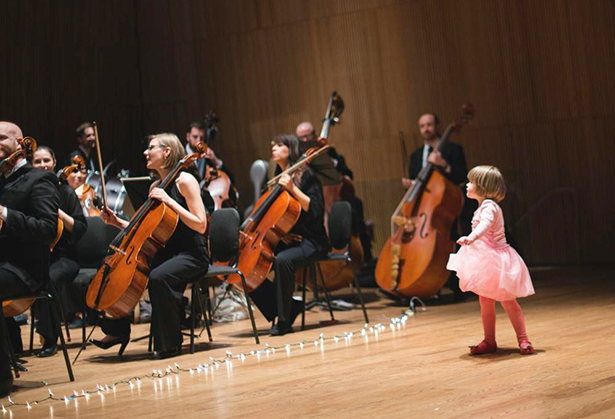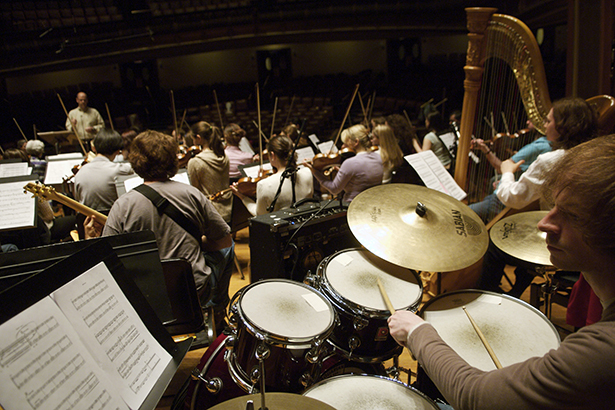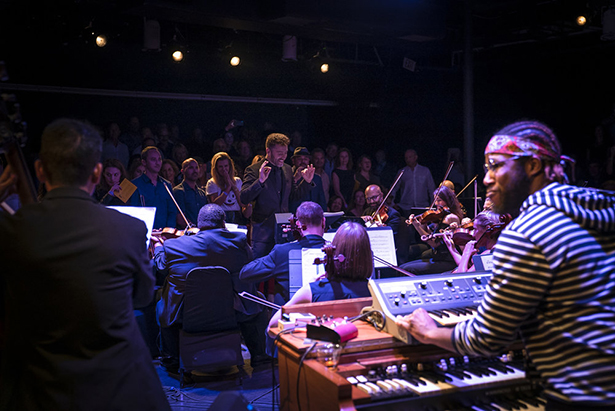NEWSLETTER
|
The New American Orchestras: Engines of Fresh Energy, Ideas By George Gelles
When the League of American Orchestras hosts its 74th annual conclave early this June in Nashville, Tenn., the organization and its constituents have much to celebrate and some worrying trends to consider.
Orchestras remain “the king-pin of the international music industry”, as the eminent composer-critic Virgil Thomson wrote in The State of Music in 1939, and American orchestras, 1,200 strong in all 50 states, can take pride in their artistic accomplishments.
Riffing on a performance given by the Boston Symphony, the invaluable Alex Ross noted qualities that the concert-goer often finds: the “conjoining of power and precision (which) is awesome to witness, and…occasions justifiable professional pride”.
A measure of the success of this country’s orchestras can justifiably be attributed to the work of W. MacNeil Lowry, universally known as Mac. A man whose modest demeanor belied a passion for the performing arts, Mac came to the Ford Foundation in 1953 as head of its education program, became director of the arts and humanities program in 1957 and was named a vice president in 1964, from which position he retired a decade later.
Lincoln Kirstein, co-founder with George Balanchine of the New York City Ballet, called him “the single most influential patron of the performing arts that the American democratic system has produced”.
I was privileged to be among his colleagues in the Office of the Arts as his work and that of others at the Foundation grew into such a singular influential force.
Mac advocated and won support for a broad swath of the performing arts. Among the earliest music grants made by the Foundation at his behest was $210,000 in 1957, almost $2 million in today’s money, to enable symphonies nationwide to commission works by American composers.
Praiseworthy though this program was, his most consequential initiative was the Program for Symphony Orchestras, implemented in 1966 and correctly characterized in a recent Rockefeller Archive Center Research Report as “(t)he largest single act of arts philanthropy in the history of the United States….a broad attempt to professionalize U.S. orchestras and legitimize orchestral performance as a serious career path”.
It was, said the report, “a ten year, eighty million dollar program for American symphony orchestras. Through a combination of matched endowment fund contributions and unconditionally distributed expendable funds, the Ford Foundation dramatically altered the condition of the professional orchestral community in the United States by encouraging longer seasons, more concerts, higher pay for musicians, and an improved artistic product.
“Considered quantitatively, the Ford Foundation’s Program for Symphony Orchestras—including the matching funds raised by the orchestras themselves—resulted in an outlay of more than $160 million for symphony orchestras. Adjusted for inflation, that amount would be worth roughly one billion dollars in 2016, or more than six times the 2016 congressional appropriation for the National Endowment for the Arts.”
Yet, despite Mac’s farsightedness and the Foundation’s largesse, today’s traditional orchestras share existential concerns. The broad gains won through the Program for Symphony Orchestras have partially eroded.
In 2015, the League of American Orchestras commissioned an ambitious study, titled “Reimagining the Orchestra Subscription Model”, that makes for sober reading. Its most worrisome finding is that in the decade preceding the study, “overall ticket sale volumes…declined at an annual rate of 2.8%” and “subscription sales…declined by nearly 2% per year. Unfortunately, the situation is worse than it may initially appear, because subscriptions are closely tied to another critical source of income—individual donations.”
During the decade reviewed, 88 percent of these donations came from subscribers, and should they leave, their donations might follow.
For generations, subscription revenues have been an orchestra’s mother’s milk, nurturing growth and sustaining health. Yet, selling subscriptions is proving to be ever more difficult as once-loyal subscribers prefer to attend fewer performances of particular interest rather than commit to an entire season that the symphony has planned, or “curated” to use the word du jour.
Like all organisms, orchestras evolve, adapting to changing fashions in musical styles, fads in orchestration and foibles in the marketplace. In the instruments they employed or ignored and in their place and purpose in society, Monteverdi’s orchestra was not Mozart’s, and Bach’s was not Beethoven’s.
Beethoven’s, however, is very much the traditional orchestra of today, though ours is larger, louder and, of course, more varied in its repertory.
We attend orchestral performances in concert halls that, with few exceptions, might have been built in the nineteenth century, as indeed some storied ones were. And we accord the musicians a reverence recalling an earlier day. They are arrayed on stage hierarchically to perform for our pleasure, and a formality exists for expected attire: the audience dresses as if for a special occasion, and the musicians often appear in formal wear that recalls the servants’ livery in “Downton Abbey”.
The ossification of the symphonic experience is not something that Mac—that anyone—could have foreseen. Over the past half century, societal changes and waves of cultural renewal have created a different world, with different expectations and different challenges.
In a phenomenon of which Mac would surely have approved, a new breed of orchestra has emerged, providing an antidote to the perceived symphonic stuffiness that might partially explain audience attrition. These ensembles turn the conventional concert experience on its head: programs reflect contemporary sensibilities; venues are often in alternative spaces—art galleries, bars, armories—rather than concert halls; and informal interactions are actively cultivated between musicians and their audiences.
Springing up nationwide over the past several decades, and finding audiences and broad recognition through live performance and recordings, you’ll find these groups in, among other places, New York City (The Knights, the Experiential Orchestra, Alarm Will Sound and NewOrch), in Boston (A Far Cry, the Unitas Ensemble and the Boston Modern Orchestra Project), in Portland, Ore. (Third Angle) and in Miami (the Nu Deco Ensemble).
The ethos they share is articulated by the newest and perhaps spunkiest of the lot, the Brooklyn-based NewOrch: “….an evening with NewOrch is not an evening with your parents’ symphony orchestra. Our concerts are different. Shorter programs, boozy after-party, swanky locations, user-friendly experience.”
Engines of fresh energy and ideas, these ensembles offer a new paradigm, boozy after-parties aside, for orchestral concerts going forward.
We might date the growth of these groups to a provocative call-to-arms issued by Ernest Fleischmann, the long-time visionary executive director of the Los Angeles Philharmonic. In a commencement address at the Cleveland Institute of Music in 1987, he trumpeted that “The Orchestra is Dead: Long Live the Community of Musicians”.
Ever polemical, he pinpointed a perceived incompatibility between cutting-edge creativity and conventional traditions of symphonic performance. Matching his words with action in the year of his exhortation, Fleischmann started the Green Umbrella concerts, a new-music initiative under the aegis of his Los Angeles orchestra.
Yet, however successful and seductive these groups might be, they are overshadowed in number and in the public eye by traditional orchestras, whose perilous health cannot be ignored. “Should corrective measures not be taken,” we read in the League of American Orchestras’ report, “the situation can be expected to worsen.”
Further, as one of the study’s authors told The Wall Street Journal, this moment presents “a classic innovator’s dilemma. You know the old product isn’t working that well. But if you change, you lose revenue in the short term. You want to change when you’ve got a little leeway, not when you’re in a panic situation and you have already lost your audience.
Now is the time to create a new model….”
Norman Lebrecht, the Cassandra among critics and the industry’s most insightful and irritating gadfly, nailed a possible source of the problem from his perch in London. After assessing the various rationales used to explain a shrinking audience—avoiding the issue of soporific programs and dismissing the notion of abbreviated attention spans—Lebrecht focused on a graying audience and ways in which it is catered to, fruitlessly, by many orchestras.
He suggested that “the concert hall atmosphere is about as lively as a cruise liner, its intellectual magnetism as potent as a pension plan”, and asked, “Why would any red-blooded post-modern person want to spend an evening in God’s waiting room….?”
Lebrecht’s tart observation echoes a finding in “A Decade of Arts Engagement”, a 2015 study issued by the National Endowment for the Arts. More politely, it states that “Older adults are the only demographic subgroup to show an increase in performing arts attendance over a decade ago. Their rates of attendance at classical music, opera, musicals and non-musicals were significantly higher in 2012 than in 2002.”
Can our traditional symphonies regain traction? Of course they can, and I believe that the newer ensembles offer useful suggestions:
Make concert halls hubs of civic activity, and not just shrines where concerts are heard. Invite and involve community organizations of all stripes, to utilize, as schedules allow, its lobby, its rehearsal rooms, its stage.
Embrace fresh repertory. Traditional symphonic music spans a wider gamut than you might imagine, and warhorses, while justly beloved, have too often outworn their welcome. Just ask any empty seat.
Open the repertory to companies of color—of all colors and ethnicities—and not predominantly to those who represent the European mainstream. And embrace women composers, too long consciously ignored. Among my current favorites are Unsuk Chin, Korean-born and Berlin-based; Pulitzer Prize winner Jennifer Higdon; and Missy Mazzoli, whose music conjures a world of passion and intellect. Widely recorded, their compositions soar and, along with works of their peers, should be a core of contemporary programs.
Rethink the conventional schedule, with an occasional shorter midday performance on a weekend, and freshen the atmosphere, with performers dressed more like normal people and less like hired help.
Other approaches will emerge, and a knee-jerk “impossible” will likely greet such suggestions. Most institutions say “no” by default.
But, at a time when traditional orchestras are dealing with issues of artistic and fiscal health, it is imperative that they rethink and refine their profiles and priorities.
Mac Lowry said it best. In “The Arts and Philanthropy”, a speech given at Brandeis University in 1962, he reminded his audience that, “At its most basic level, art is not about money, or facilities, or social acceptance. It is about the surge of artistic drive and moral determination. It is about the individual professional or artistic director.”
To recapture this sense of creative excitement is our traditional orchestras’ paramount job.
George Gelles, who worked in the Foundation’s Office of the Arts from 1977 to 1981, writes extensively on music and dance, including for this newsletter. His most recent article was “Where Are All the American Orchestra Conductors?” in the Fall 2018 issue.
|




